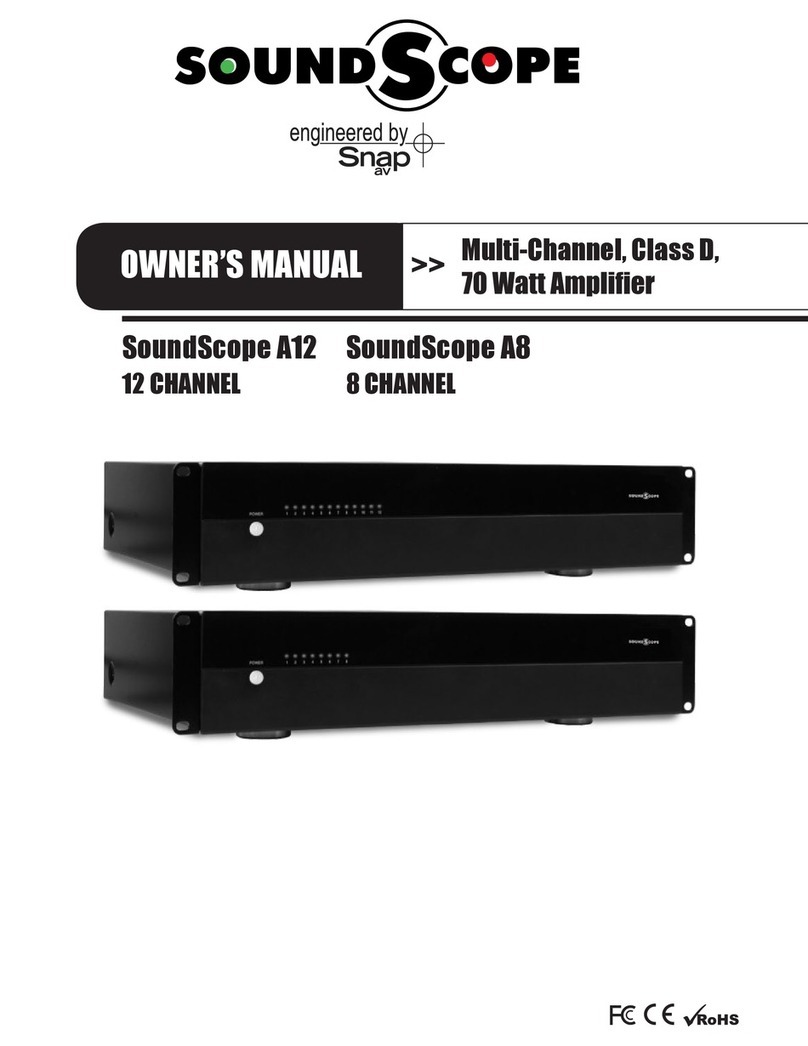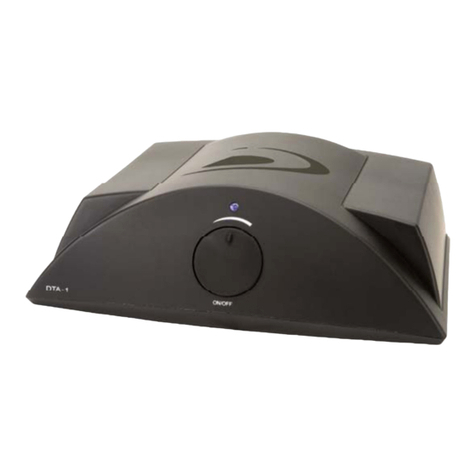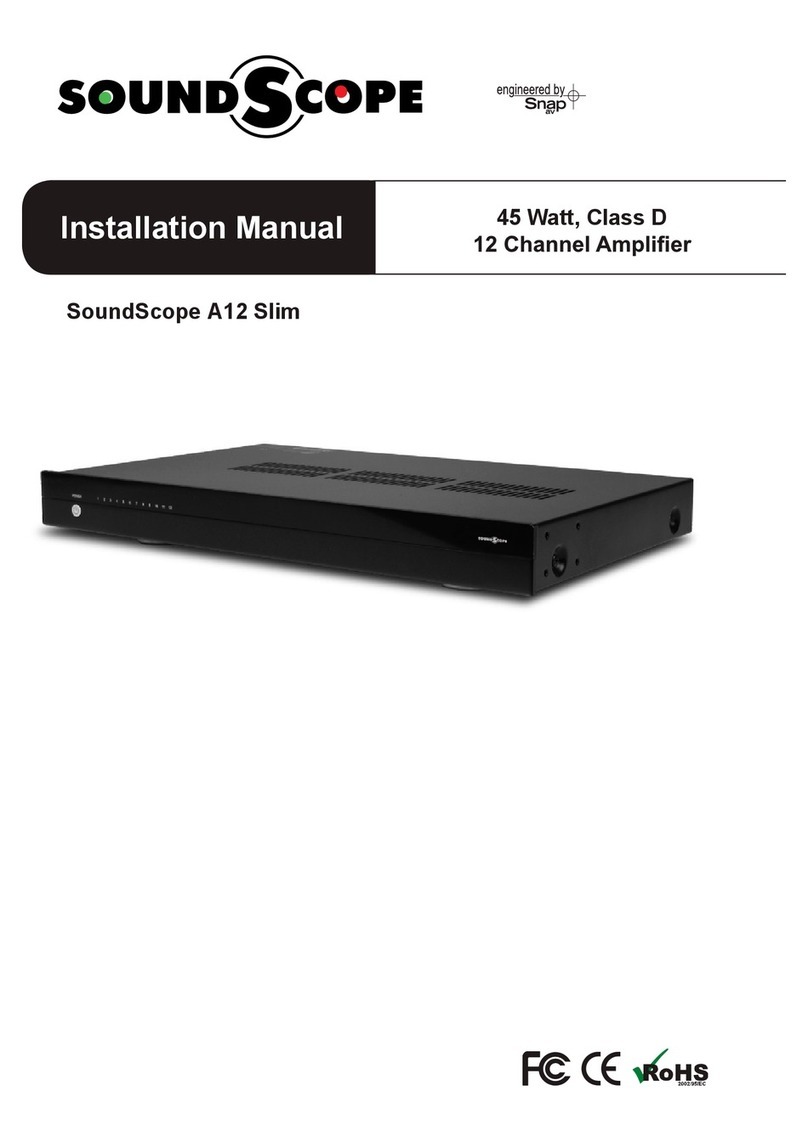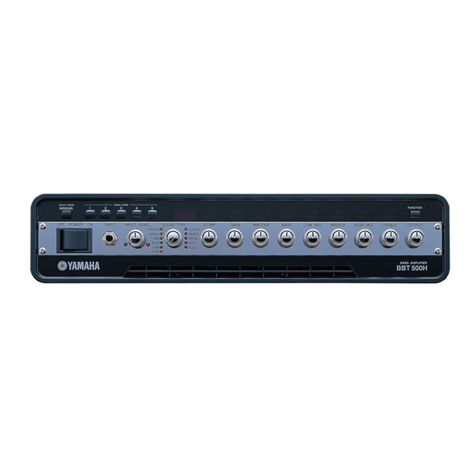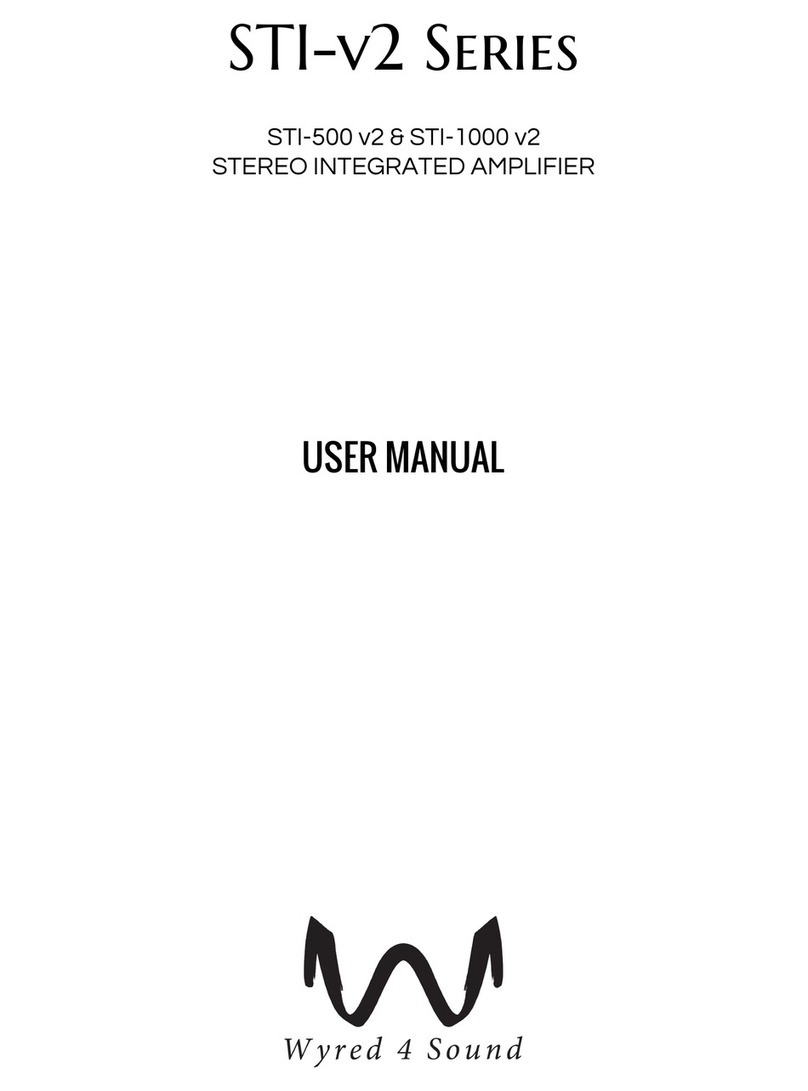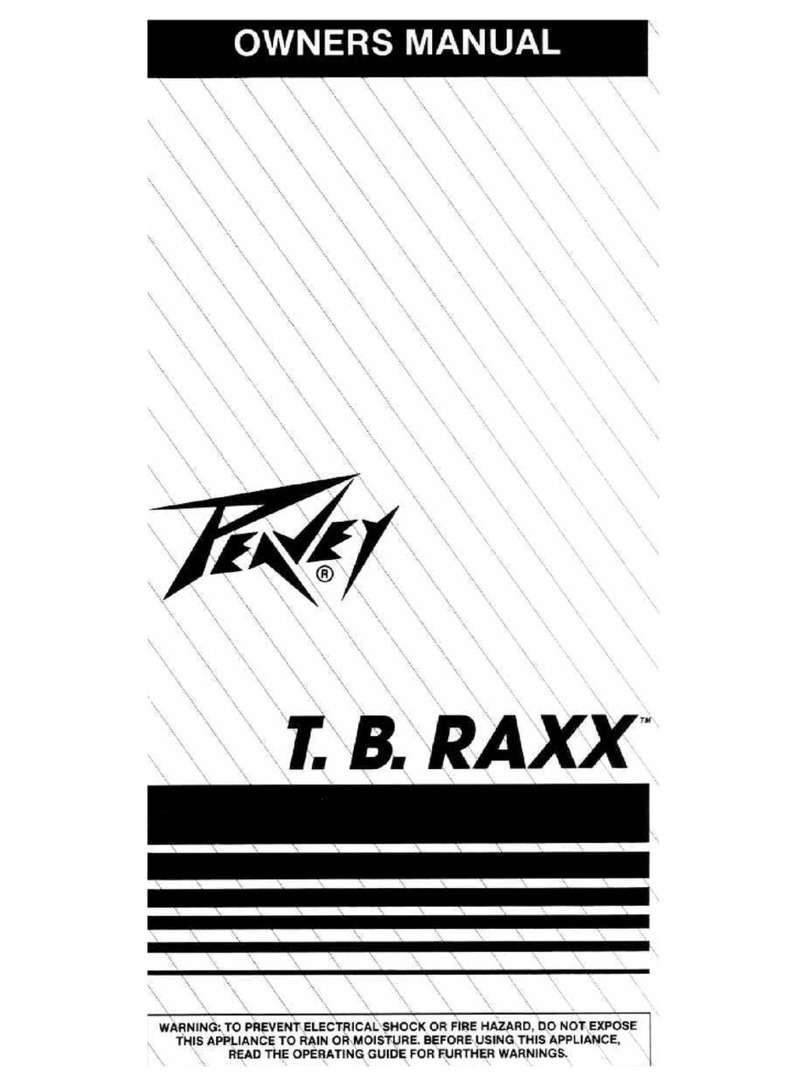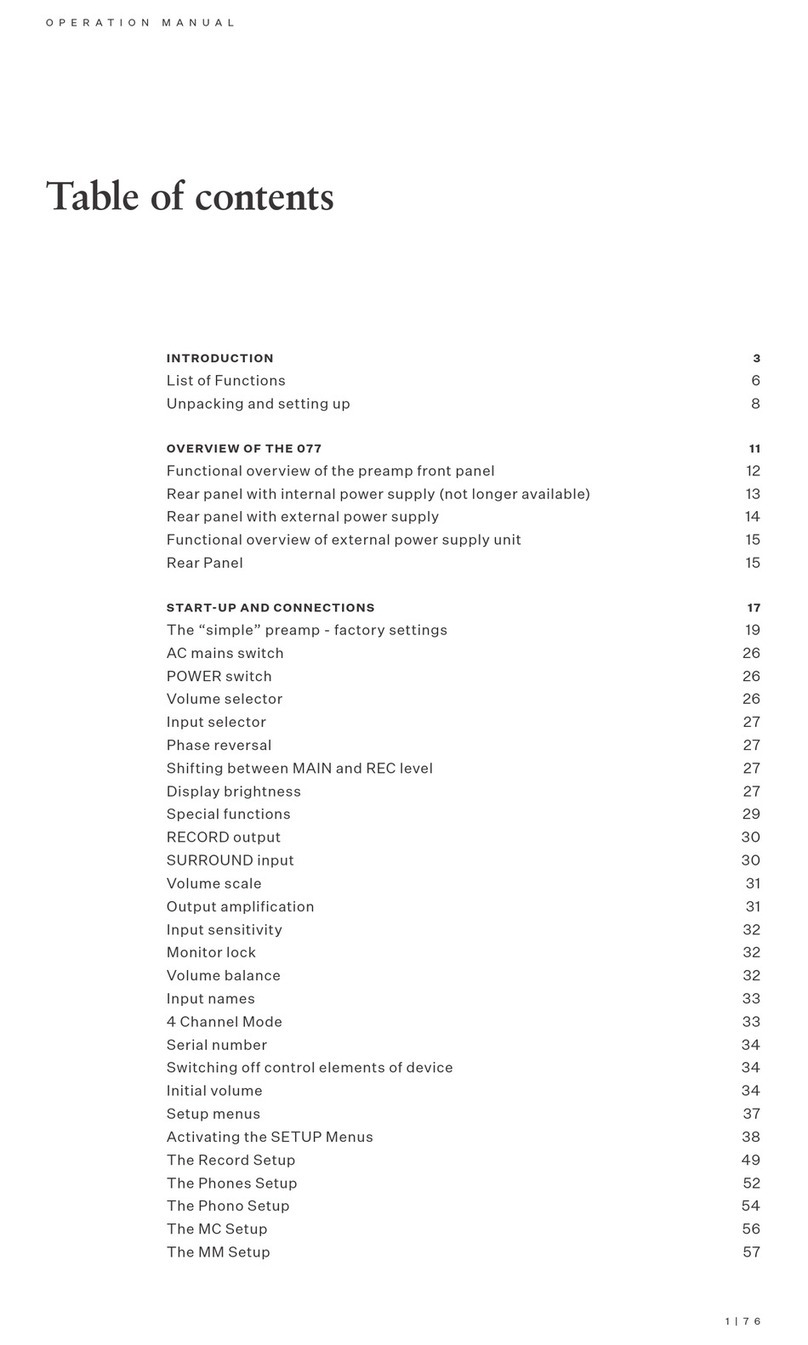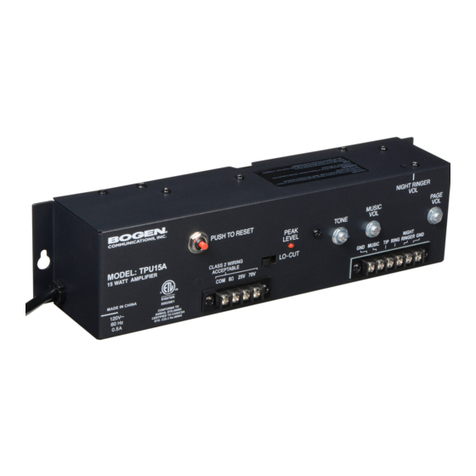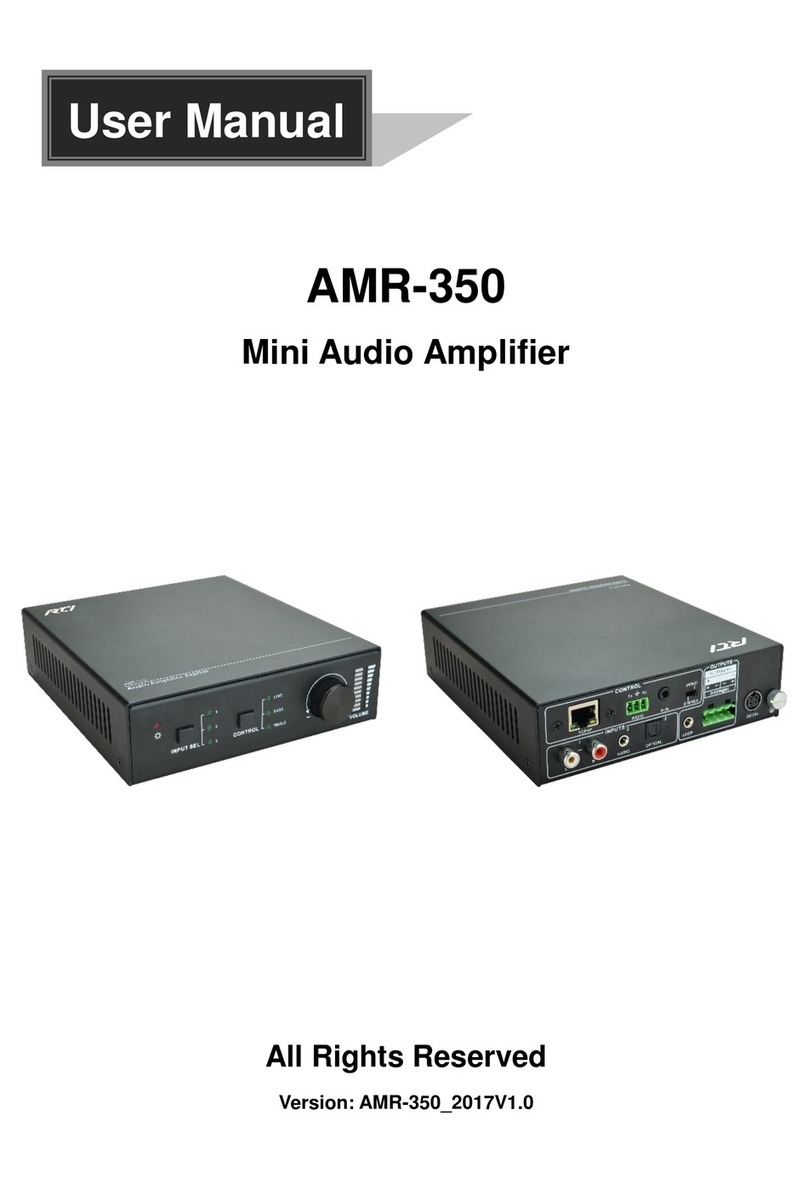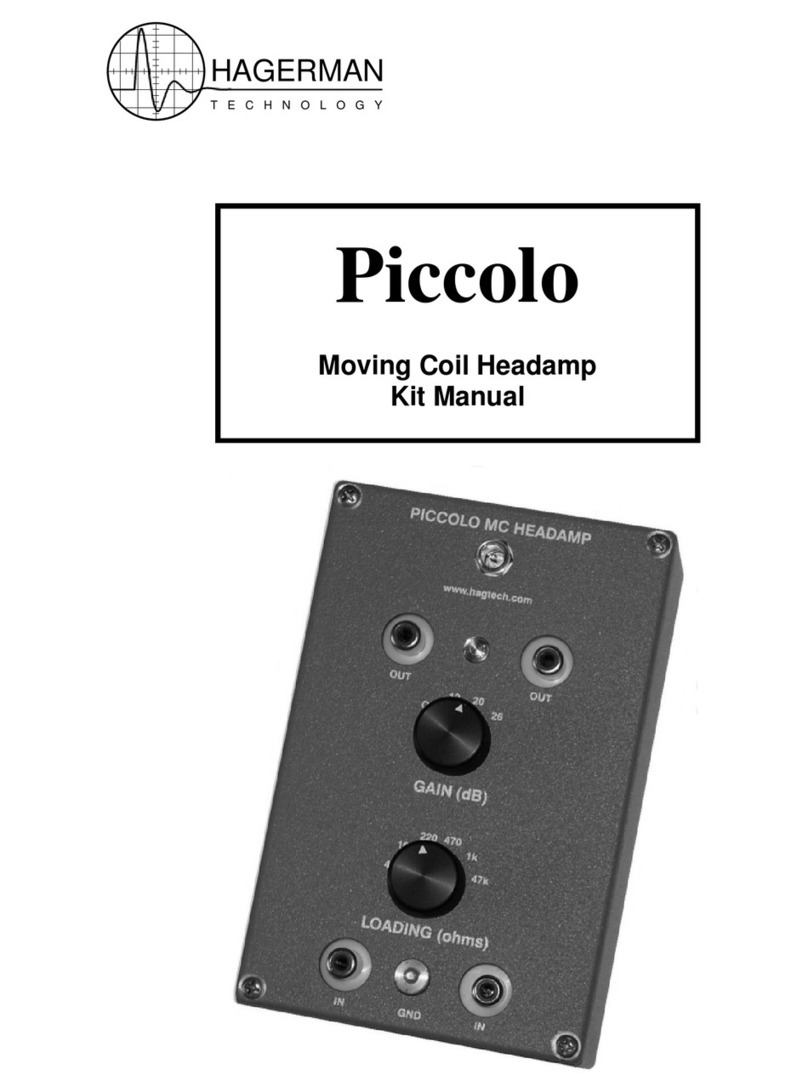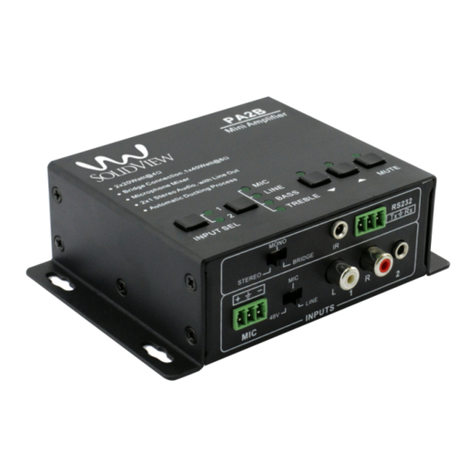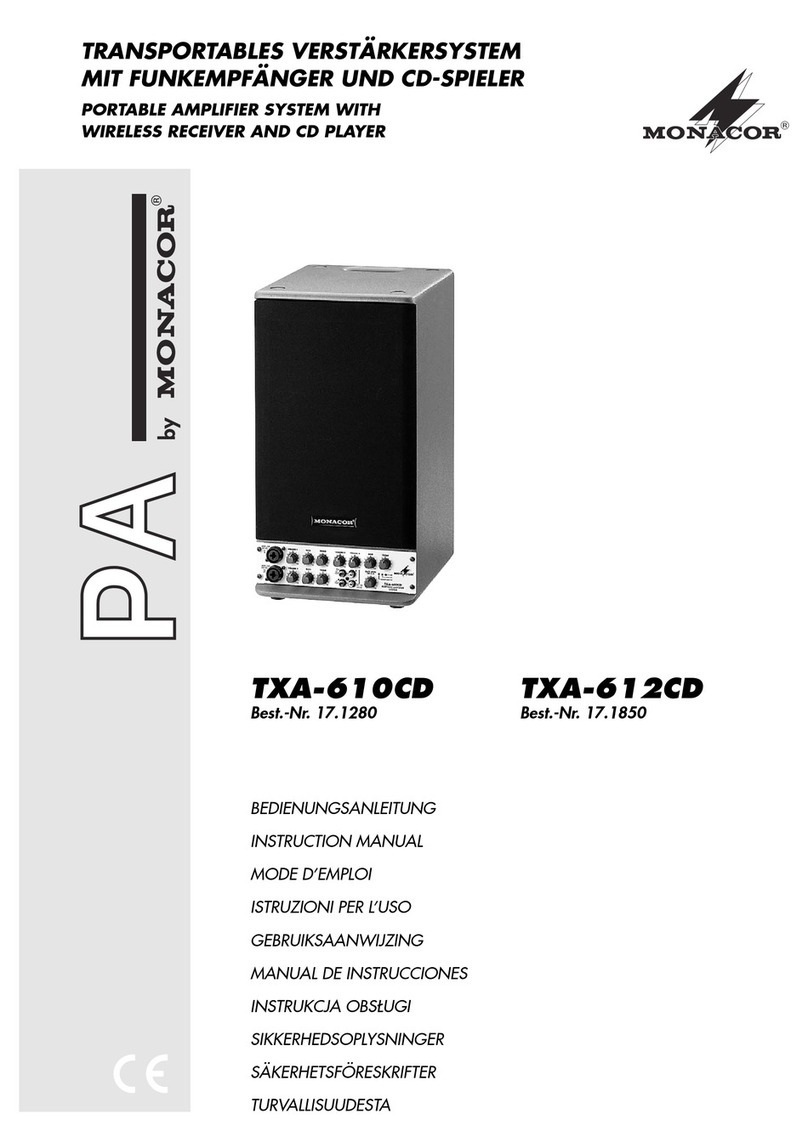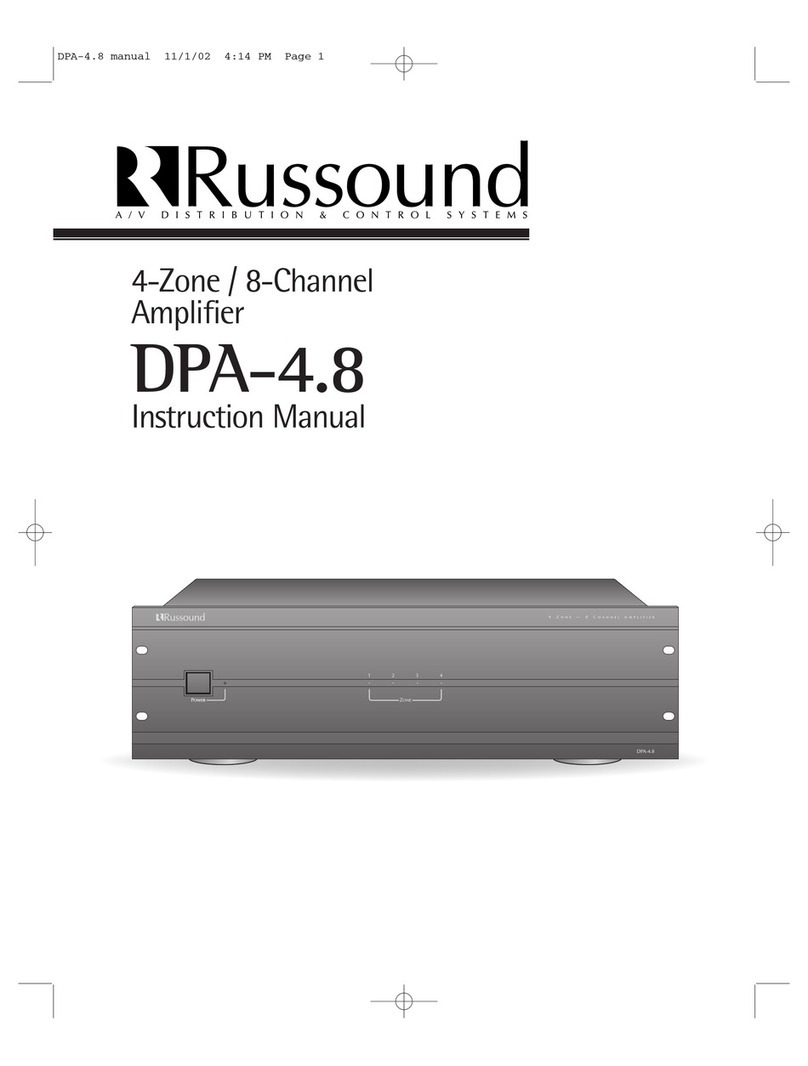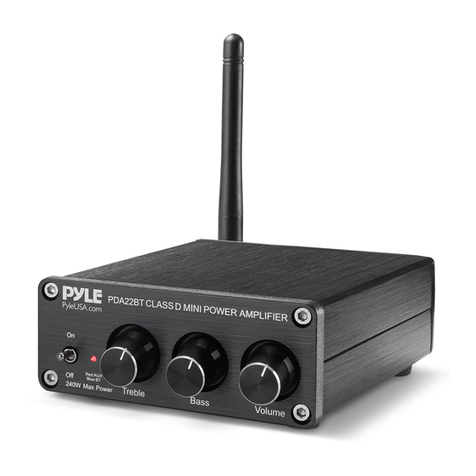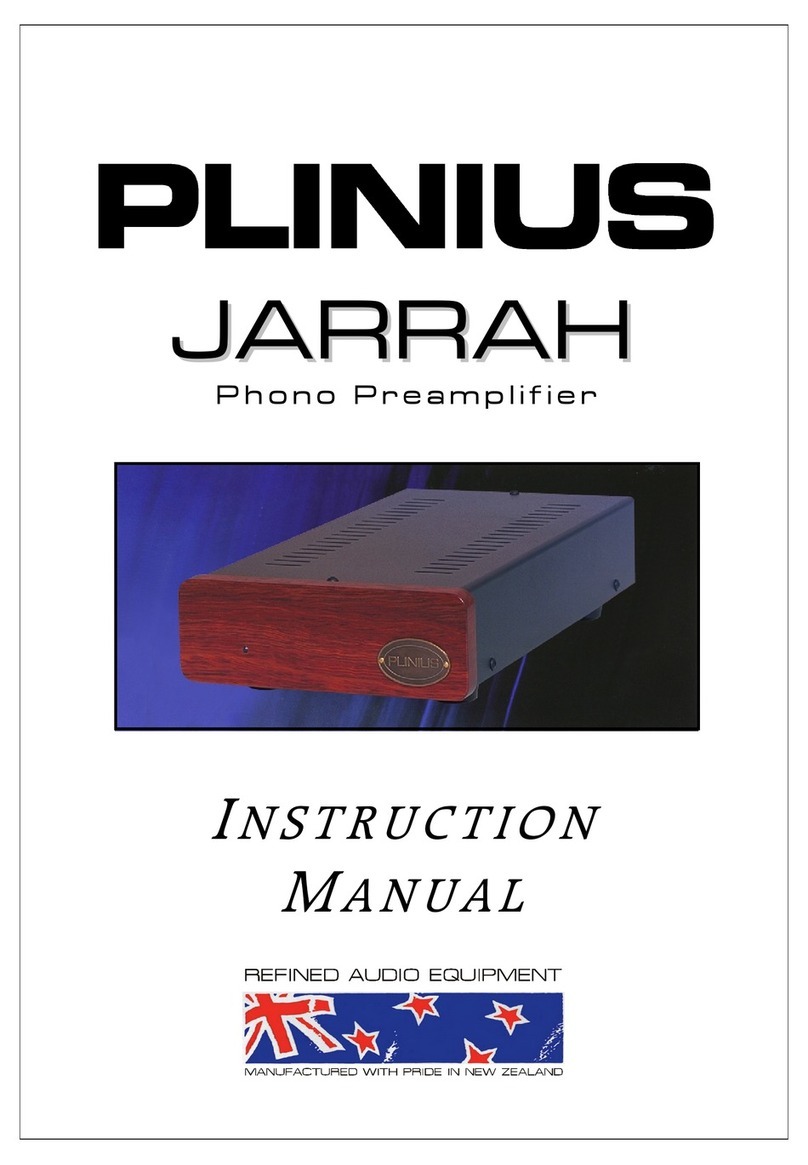SoundScope A12 Slim User manual

User Manual
Twelve Channel
Multi-Zone Amplifier

(2)
INSTALLATION:
Dayton Audio amplifiers are designed to help deliver a great audio experience. However, where you place the amplifier can
have a large effect on the performance you receive, and the life of the unit. If you are not rack-mounting the amplifier, posi-
tion it with all feet resting on a solid level surface. Be sure that the amplifier is in a well-ventilated area and DO NOT install
the amplifier near a source of heat or in an extremely humid or wet location.
CAUTION: All connections and switching must be done with the amplifier’s power switch positioned to ‘Off’. Connect the
power cord last to be sure that the amplifier is off during all of your connections and set up.
FEATURES:
• 12 channels (6 stereo zones) in one convenient enclosure
• Stable Class AB design delivers superior audiophile sound
quality and performance
• Bridgeable channel outputs provide additional power
when needed
• Independent channel gain controls allow the output of
each speaker to be perfectly matched
• Switchable 115/230V input voltage
• Manual, auto, or triggered on/off for integration into any
automated system
• Multi-stage protection circuitry for reliability and easy
troubleshooting of audio system
• Installer-friendly setup and connections
• Can be converted easily between rack-mount and
tabletop configurations
•Heavy-duty steel chassis with brushed aluminum faceplate
FRONT PANEL:
1. Master Power Switch / Indicator LED
Front panel pushbutton power switch turns the amplifier
on and off. When the switch is on and the indicator LED
is red, the amplifier is in standby mode. The remote turn
on switch (located on the rear) is either in the “trigger”
or “auto” position. When the LED is blue, the amplifier is
fully active. The master power switch will turn off the am-
plifier no matter which power mode has been selected.
2. Zone Status Indicators
otDELroloc-ibasahsenozroslennahcforiaphcaE
indicateitsoperational status.Theseindicators provide quick
and easy troubleshootingof thesystem. Ifthe circuitry deter-
mines that a channel must be shut down due to excessive
heat orlow impedance (a short), only the channelsthat are
affected will be turned off causing the zone LED to turn red.
The remaining zoneswill continueto operateand maintain a
blue LED status. Once the condition hasbeen corrected for
the zone in question, the status LED will return to blue.
Note: When the power LED isred and the zone status LEDS
are not lit (off) indicatesthe unit is in stand by mode.
~115VAC 60Hz Fuse:T8AL
~230VAC 50Hz Fuse:T4AL

(3)
REAR PANEL:
3. BUS Line Inputs / Outputs
The A12 has two common or BUS inputs that
receives audio signals from standard line-level audio
sources and sends them to any or all channels. The BUS
line outputs are direct feed-through to allow the BUS
inputs to be fed to other amplifiers. Be sure to use high
quality RCA cables that feature low impedance, shielding
and high quality connectors.
4. Remote Turn-On Switch
This switch selects the turn-on stimuli that will put the ampli-
voltage going into the trigger input to activate the amplifier.
“Auto” setting senses a signal on the RCA line-level inputs
and automatically puts the amp in ready mode. “On” setting
puts the amp constantly in ready mode so that it can be
controlled by the master power switch on the front panel.
minutes to return from ready to standby mode.
5. Trigger Input / Output
The trigger input is a handy feature when connecting the
plug jack will accept a 3-30V AC/DC output from another
device, or from a separate power supply. When the trigger
input is energized, the amp turns from standby to ON mode.
When using the A12 with a receiver without a trigger
output, the voltage can come from a 12V wall wart (3.5mm
tip-positive connector) plugged into the receiver’s switched
outlet and the trigger input. The A12 can also provide
an output trigger voltage (12DC @500mA max.) to turn on
and off other devices in the audio system. When the ampli-
Note: Remember there is a delay of approximately 15
minutes before the amplifier goes to standby when using
the “Auto” turn-on mode.
6. Channel Gain Control
Each channel has its own independent level adjustment.
This allows the output level of each speaker to be per-
fectly matched to its area. It can also be used to limit the
maximum audio level in a certain area.
7. Bridging Switch
combined to increase the total power output.This is helpful
when extra power is needed in certain areas.
Note: The minimum impedance for bridged channels is 8
ohms. Also, please observe the proper speaker wiring when
bridging channels. Input selection and volume settings for
bridged channels will be controlled by the left channel.“BR”
is bridged mode and “ST” is non-bridged or stereo mode.
CAUTION: Only change switch positions when the
amplifier is turned off.
8. Input Selection Switch
Each channel is capable of delivering the source from
many inputs. The three main inputs are BUS 1, BUS 2
and LINE IN. The selection for these inputs is done via
the Input Selection switch associated with each channel.
Select the desired source input. Set the Input Selection
switch to BUS 1 (will play source connected to the BUS
1 input), BUS 2 (will play source connected to the BUS
2 input) or LINE IN (will play source connected to that
channel’s LINE IN).
CAUTION: Only change switch positions when the
amplifier is turned off.
9. Speaker Output Terminals
The A12 uses high quality Phoenix style connectors
for the speaker connections. Use 14-18 gauge stranded
two-conductor loudspeaker wire. Ensure that at least
2 inches of each conductor are separated. Strip away
¼ inch of insulation from each conductor. Connect the
appropriate conductor to each screw terminal, observing
correct polarity. Also, please observe proper speaker wir-
ing when bridging channels.
10. Individual Channel Input
All twelve channels have their own dedicated input that
allows the connection of audio sources in addition to
the common BUS inputs. This is useful when using the
A12 with an audio matrix switcher.
11. AC Voltage Switch
The unit is set at the factory for 115V U.S. operation; simply
connect the included IEC power cord to your wall outlet.
For 230V operation, move the voltage selector switch to the
230V position. When operating at 230V the internal fuse
located in the IEC socket should also be changed. In most
230V applications a separate power cord will be required
and is not included.
12. IEC Power Connector
The unit comes with an IEC jack that permits removal of
-
ing the power cord for different countries. The IEC
socket also houses the main fuse holder. Plug the power
cord supplied with the amplifier into the amplifier and a
grounded wall outlet or appropriate surge protector.
CAUTION: DO NOT plug the amplifier’s power cord into
a switched outlet, such as what is provided on some Sur-
round Receivers. If you wish to have the amplifier turn on
when the Receiver is powered up, use one of the power
modes, such as Trigger or Audio.
CLOSE UP OF CONNECTIONS

(4)
NOTES ABOUT HUM:
While the A12 has been designed to minimize the possibility
of hum in the audio system, it is still possible that a hum will occur
in rare circumstances. Its safety grounding can create a path for
small amounts of 60 Hz energy to travel trough the line-level audio
system.While not dangerous, this energy can cause difficulty with
the auto signal sensing circuit, and at the very least will interfere
with the quiet enjoyment of your system. The first course of action
should be trying to make sure that all of the audio components are
connected to either the same electrical outlet, or at least into the
same circuit branch. Next, cable TV systems are notoriously the
culprit, so be sure to try disconnecting all coaxial feeds that are
connected to the system. If this solves the problem, install a coaxial
line isolator and reconnect the system. In the very worst case, a
line-level audio isolator/transformer connected to the line-in of the
subwoofer amplifier will usuallysolve the problem.
SPECIFICATIONS:
Rated Power Output: 40 Watts per channel RMS at 8 ohms
60 Watts per channel RMS at 4 ohms
Bridged Power Output: 80 Watts per channel RMS at 8 ohms
(8 ohm minimum)
Input Sensitivity: 380 mV for full output with all level
controls at max.
Input Impedance: 18K ohm
Frequency Response: 5 Hz to 72 kHz
Distortion: .09% THD 20 Hz-20 kHz @ 40W (8 ohm)
Distortion (Bridged): .30% THD 20 Hz-20 kHz @ 80W (8 ohm)
Channel Crosstalk: 80 dB
Signal to Noise Ratio: 95 dB A-weighted
Efficiency: 60%
Power Requirements:115/230 VAC, 50 Hz/60 Hz
Stand-By Power Rating: 115V 80W;230V 75W
Auto Turn-On Sensitivity: 18.84mV
Dimensions:16.7” W x 4”H (including feet) x 14.25” D
Weight: 30 lbs.
TYPICAL 6 ROOM INSTALLATION
Important Safety Instructions
To reduce the risk of electric shock, do not remove cover. No user service-
able parts inside. Refer servicing to qualified personnel. To reduce the risk
of fire and shock do not expose unit to rain or moisture. The unit should be
connected to an earth grounded AC electrical socket. The unit should be
operated in a well ventilated area. Minimum clearance is 2 inches from the
ventilation openings.
Note: Unit is set at the factory for 120V operation. Be sure to change the fuse
(4A rating) before switching to 230V operation.
Other manuals for A12 Slim
2
Table of contents
Other SoundScope Amplifier manuals
